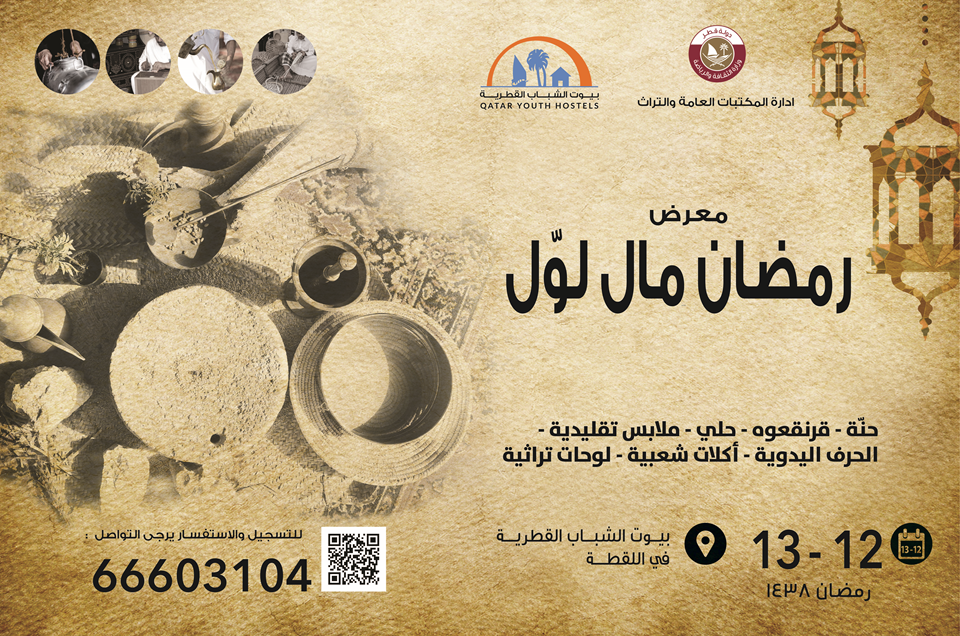
- On June 6, 2017
- In غير مصنف
- Tags
No Comments
وتحتفل بليلة القرنقعوه بمقرها يومي 12 و13رمضان : بيوت الشباب تنظم معرض “رمضان مال لول “
بمشاركة ادارة المكتبات العامة والتراث بوزارة الثقافة والرياضة تنظم بيوت الشباب القطرية معرضا تراثيا رمضانيا تحت عنوان “مال لول “على مدار يومي 12 و13 من رمضان الجاري بمقر البيوت بمنطقة اللقطة ،يتضمن معروضات تعريفية بالتراث القطري القديم ،بما يقدم لرواد المعرض فكرة متكاملة بالصور والشرح عن تلك القيم والمورثات القديمة لربطهم بالتاريخ القطري وتراثه الغني بالكثير من التقاليد والعادات والحرف القديمة المتميزة .
وقالت بيوت الشباب القطرية ان ابرز ما سيتضمنه المعرض ويركز عليه ،هو عرض الحرف التقليدية على راسها صناعة السدو وهو تراث بدوي أصيل ،مشيرة الى ان حرفة النسج وحياكة الصوف من الحرف التقليدية التي كانت منتشرة في البادية وما تزال إلى يومنا هذا،وذلك لارتباطها بوفرة المادة الأولية المتمثلة في صوف الأغنام ووبر الجمال وشعر الماعز والقطن.
وأشارت بيوت الشباب الى ان صناعة السدو كانت وما تزال تعتمد على جهد المراة في المقام الأول،منوهة الى انها لم تندثر خلافا لحرف أخرى كثيرة لم تعد موجودة بفعل تبدل احتياجات الناس في حقبة ما بعد النفط،حيث ما تزال الأدوات المستعملة في صناعة السدو منذ قرون مستعملة حتى اليوم كالمغزل والنول (الميشع)، والمنشزة (المدرارة)، ومن منتجات السدو بيت الشعر والقاطع (الرواق) والعدول والسقايف (البطاين)والمزاود.
واضافت بيوت الشباب القطرية ان صياغة الذهب والمجوهرات والاحجار الكريمة من الصناعات القديمة في قطرحيث تمارسها أسر ارتبطت أسماؤها بهذه الصناعة، حيث كانت أدواتها من المطارق بأحجام مختلفة والسنديان ومبارد مسطحة وأخرى خشنة أو ناعمة، والمصهر وهو المكان الذي يصهر فيه الذهب،مشيرة الى ان أهم المنتوجات الحجل أو الخلخال والقرط والأساور والقلائد وزينة الرأس كطاسة السعد وغيرها من الاشكال القديمة المميزة والمحببة لدى الجميع
وتابعت بيوت الشباب ان ابرز ما سيتضمنه المعرض حرفة التطريزوهي زركشة الملابس التقليدية للرجال والنساء وتعتبر من المهن القديمة في المنطقة ،حيث يقوم” الدرزي” بزركشة أو “تدريز” الملابس يدوياً بالخيوط الملونة والذهبية والفضية،وهو ما يسمى بـ “النقدة”. وقد تستخدم الماكينة نصف الآلية ثم الكهربائية وذلك لضمان سرعة العمل وإتقانه.
اما عن الأزياء الشعبية التي سيضمنها المعرض ،فقالت بيوت الشباب انها حرفة قديمة حيث كانت ومازالت تخاط ملابس النسوة مثل الدراعة والثوب والبخنق (المخنق أو القبع) والسروال والعباءة والنشل بأنواعه وثياب الرجال مثل ثوب الشلحات والدقلة والسراويل.
هذا بالاضافة الى الزخرفة الجصية والتي تنتشرفي معظم البيوت القديمة،حيث كان الجص (الجبس)يصنع محليا ويستخدم لكساء جدران البيوت والقلاع والقصور والأبراج والمساجد من الداخل والخارج بدلا من الطين لقدرته على تحمل عوامل المناخ والطبيعة منوهة الى الجبس يتسعمل أيضا في صناعة القوالب التي تنقش عليها الزخارف الهندسية والنباتية المجردة التي كانت تزين العديد من البيوت التقليدية في قطر،وكان القطريون يصنعون من الجص المباخر التي ما زال الناس يقبلون على اقتنائها لتزيين منازلهم.
ولفتت بيوت الشباب القطرية الى انه كان للبحر حضور بارز في الحياة اليومية للمواطن القطري منذ القدم ،ساعده في ذلك موقع البلد الجغرافي كشبه جزيرة ،مشيرة الى ان صيد السمك من الحرف القديمة التي مارسها سكان السواحل ،مشيرة الى ان تلك الحرفة كانت على قدر من الأهمية إذ وفرت للإنسان مصدراً للرزق والغذاء قبل فترة النفط
وتابعت بيوت الشبب ان صناعة واصلاح شباك صيد السمك كان لها طرق مختلفة منها المسكر والحضرة، موضحة ان الإنسان في الخليج، وفي قطر خصوصاً، عمل على تطويرأسلوب الصيد بهاتين الأداتين، فالحضرة كانت تصنع من مواد محلية كجريد النخل وحبال الليف وتستعمل لصيد انواع
ونوهت بيوت الشباب الى ان المعرض سيتضمن كذلك فنون الحنة التي كانت تعتمد على متخصصة تسمى الخضابة بعمل الحناء ووضع الحنة على كفي وقدمي العروس ويطلق على هذه العملية اسم حنة عجين وذلك بأن تعمل عجينة من الطحين وتبرم على شكل خيوط ثم تلصق على هيئة طرز هندسية جميلة في الكفين والقدمين، وتوضع الحناء على كامل الكفين والقدمين بحيث تغطي الزخرفة المعمولة من العجين سابقا
واشارت الى ان الاكلات الشعبية ستكون حاضرة بقوة في المعرض والتي تتضمن فنون الطبخ الشعبي القديم للعديد من الاكلات الشعبية على راسها الثريد والهريس وشوربة الهريس والمحمر والمضروبة والمرقوقة وكباب النخي والبلاليط والخنفروش
واخيرا قالت بيوت الشباب القطرية ان المعرض سيتضمن الى جانب ذلك فنون الاحتفال بليلة القرنقعوه ،وهى ليلة تراثية تسعى لإحياء الثراث القطري والخليجي وتذكير الأطفال بالعادات والتقاليد الشعبية في الملبس وغيرها من الفعاليات وتوزيع الحلويات .

